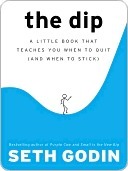More on this book
Community
Kindle Notes & Highlights
by
Seth Godin
Read between
July 20 - July 29, 2023
Just about everything you learned in school about life is wrong, but the wrongest thing might very well be this: Being well rounded is the secret to success.
Strategic quitting is the secret of successful organizations. Reactive quitting and serial quitting are the bane of those that strive (and fail) to get what they want. And most people do just that. They quit when it’s painful and stick when they can’t be bothered to quit.
Successful people don’t just ride out the Dip. They don’t just buckle down and survive it. No, they lean into the Dip. They push harder, changing the rules as they go.
The Cul-de-Sac (French for “dead end”) is so simple it doesn’t even need a chart. It’s a situation where you work and you work and you work and nothing much changes. It doesn’t get a lot better, it doesn’t get a lot worse. It just is.
Stick with the Dips that are likely to pan out, and quit the Cul-de-Sacs to focus your resources. That’s it.
The Dip creates scarcity; scarcity creates value.
The Cul-de-Sac and the Cliff Are the Curves That Lead to Failure
If you find yourself facing either of these two curves, you need to quit. Not soon, but right now. The biggest obstacle to success in life, as far as I can tell, is our inability to quit these curves soon enough.
In a competitive world, adversity is your ally. The harder it gets, the better chance you have of insulating yourself from the competition. If that adversity also causes you to quit, though, it’s all for nothing.
The next time you’re tempted to vilify a particularly obnoxious customer or agency or search engine, realize that this failed interaction is the best thing that’s happened to you all day long. Without it, you’d be easily replaceable. The Dip is your very best friend.
And yet the real success goes to those who obsess. The focus that leads you through the Dip to the other side is rewarded by a marketplace in search of the best in the world.
Simple: If you can’t make it through the Dip, don’t start. If you can embrace that simple rule, you’ll be a lot choosier about which journeys you start.
Quitting creates scarcity; scarcity creates value.
You grew up believing that quitting is a moral failing. Quitting feels like a go-down moment, a moment where you look yourself in the eye and blink. Of course you are trying your best. But you just can’t do it. It’s that whole Vince Lombardi thing. If you were just a better person, you wouldn’t quit.
The most common response to the Dip is to play it safe. To do ordinary work, blameless work, work that’s beyond reproach. When faced with the Dip, most people suck it up and try to average their way to success.
The next time you catch yourself being average when you feel like quitting, realize that you have only two good choices: Quit or be exceptional. Average is for losers.
Selling is about a transference of emotion, not a presentation of facts.
the opposite of quitting is rededication. The opposite of quitting is an invigorated new strategy designed to break the problem apart.
Short-term pain has more impact on most people than long-term benefits do, which is why it’s so important for you to amplify the long-term benefits of not quitting. You need to remind yourself of life at the other end of the Dip because it’s easier to overcome the pain of yet another unsuccessful cold call if the reality of a successful sales career is more concrete.
The time to look for a new job is when you don’t need one. The time to switch jobs is before it feels comfortable. Go. Switch. Challenge yourself; get yourself a raise and a promotion. You owe it to your career and your skills.
“Never quit something with great long-term potential just because you can’t deal with the stress of the moment.”
The best quitters, as we’ve seen, are the ones who decide in advance when they’re going to quit. You can always quit later—so wait until you’re done panicking to decide.
If quitting is going to be a strategic decision that enables you to make smart choices in the marketplace, then you should outline your quitting strategy before the discomfort sets in.


